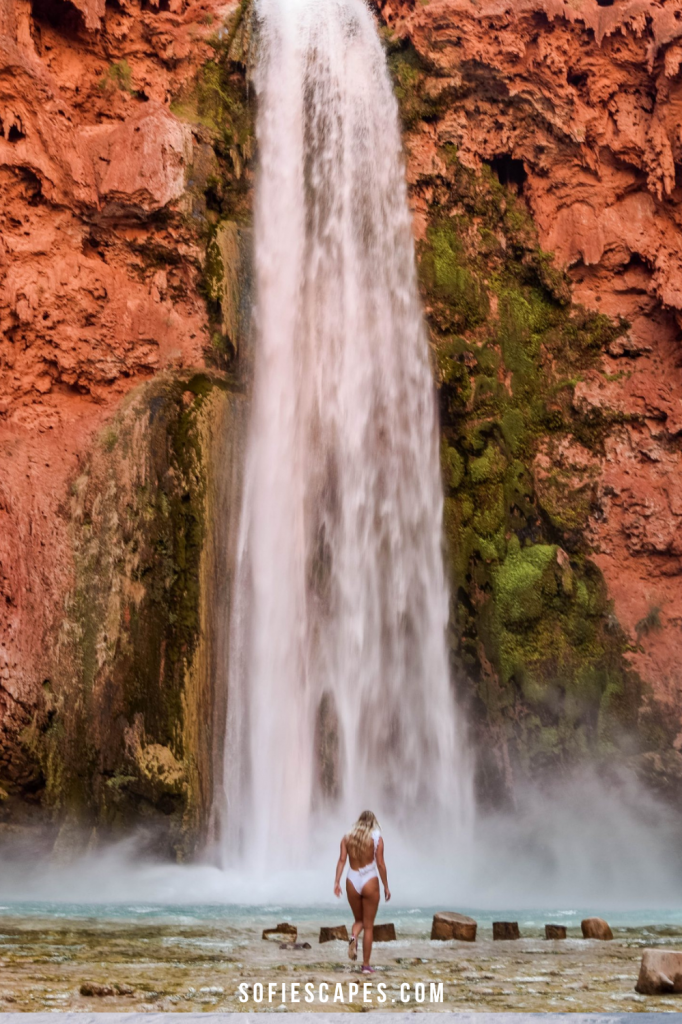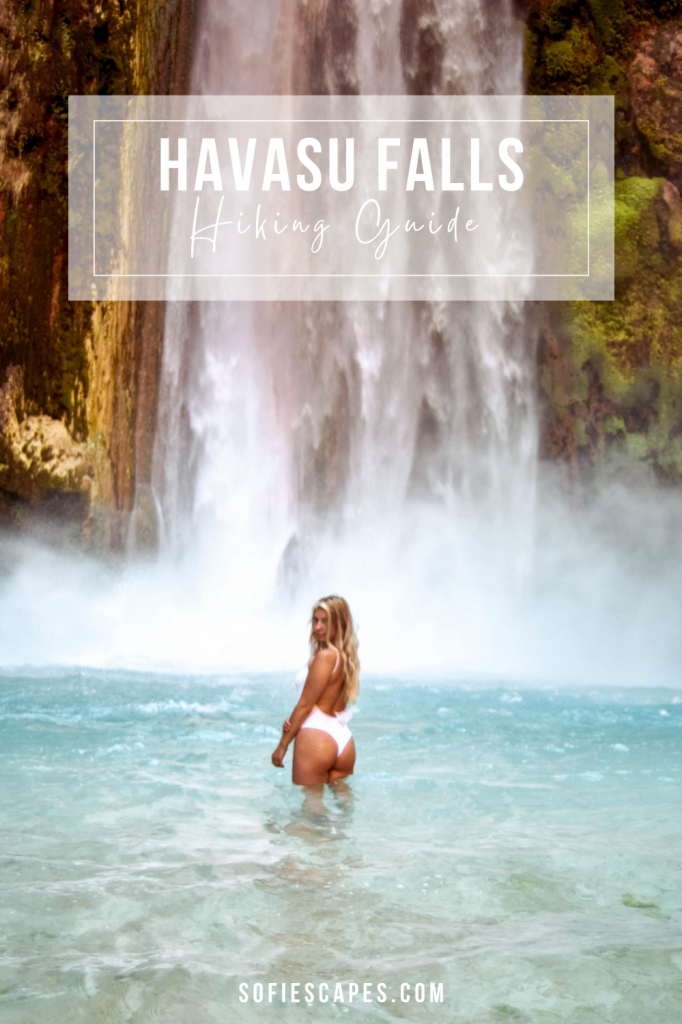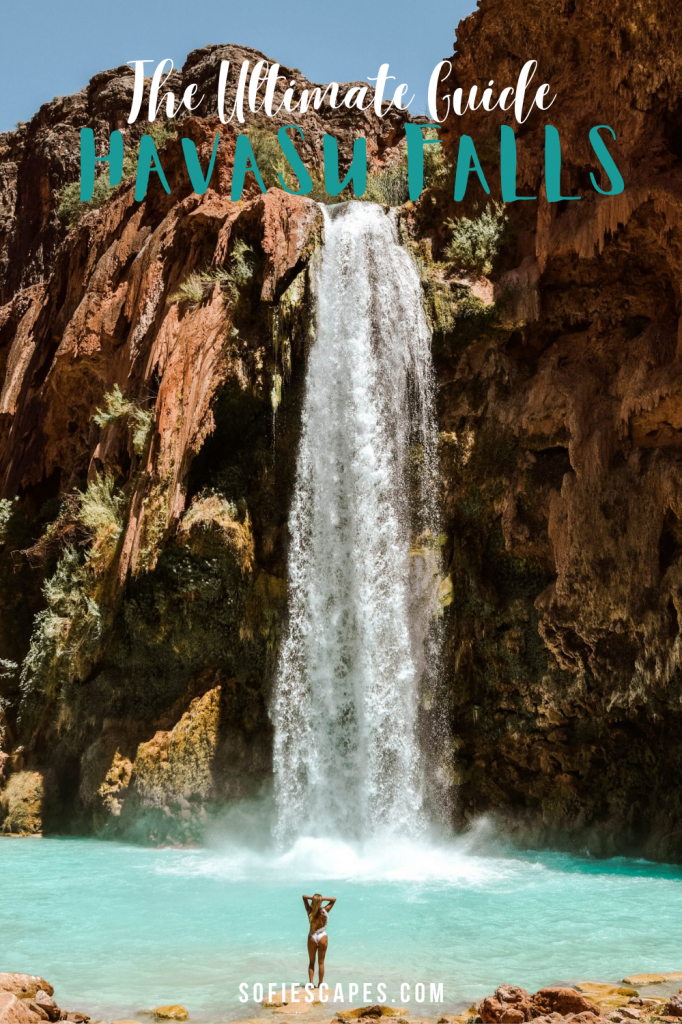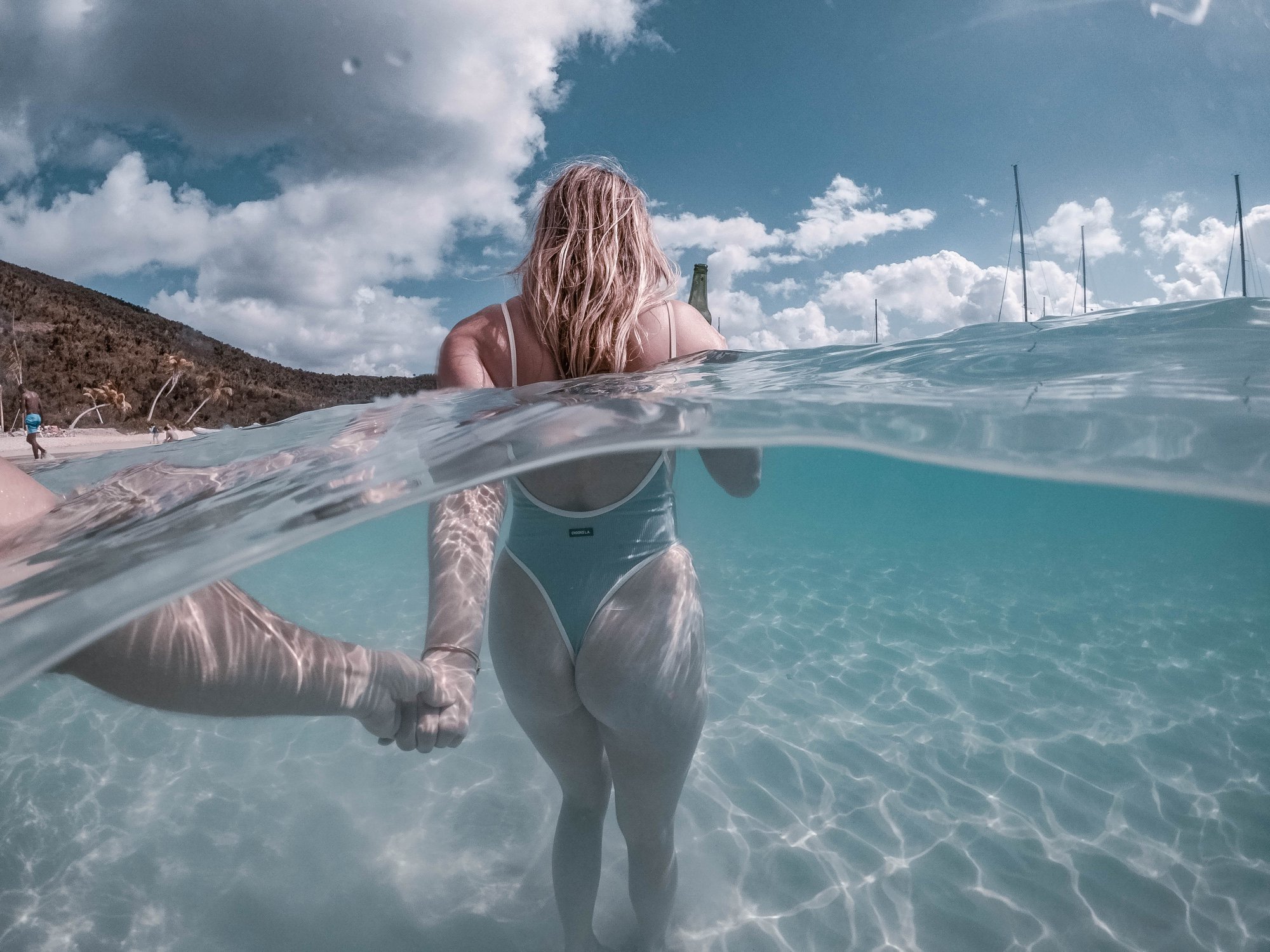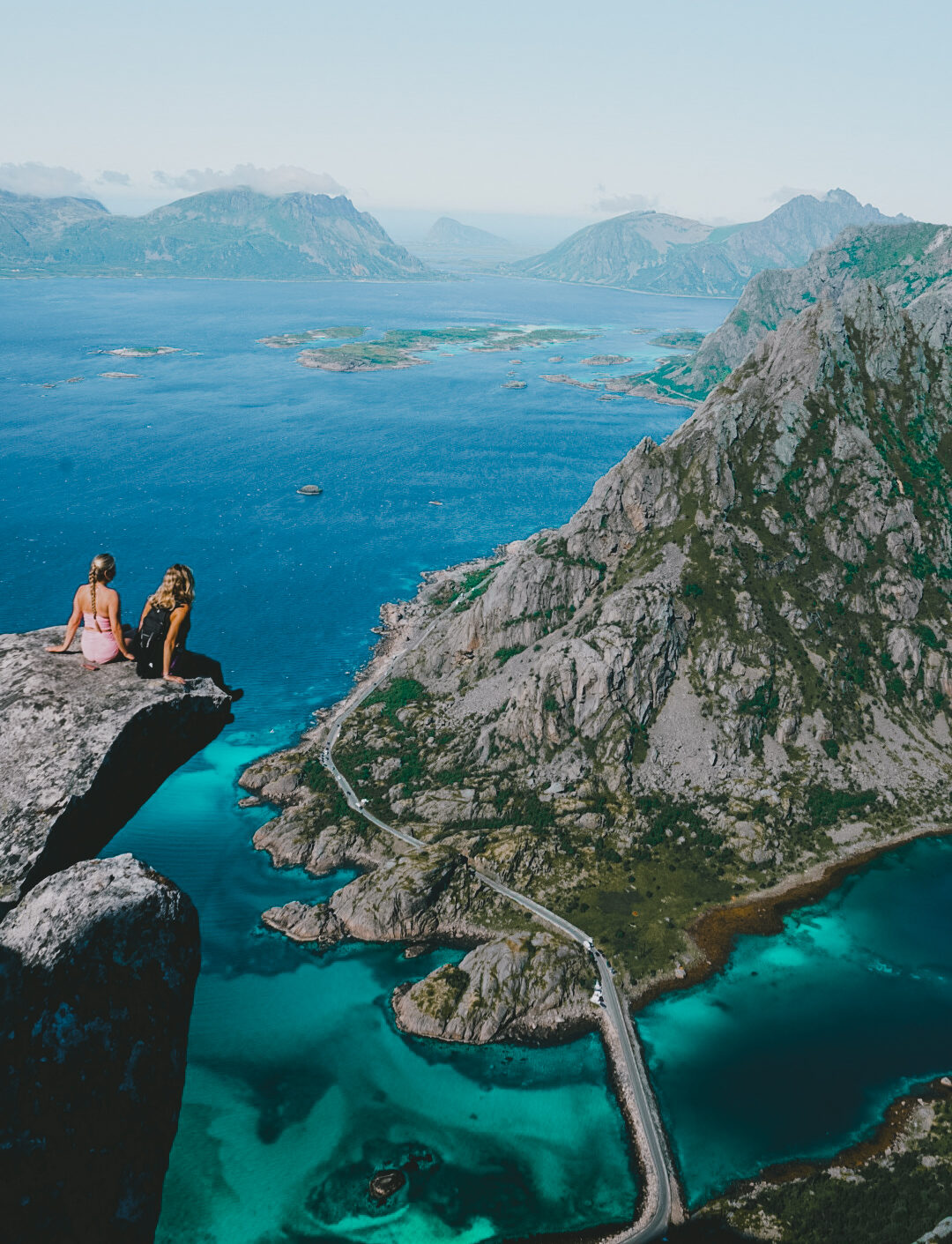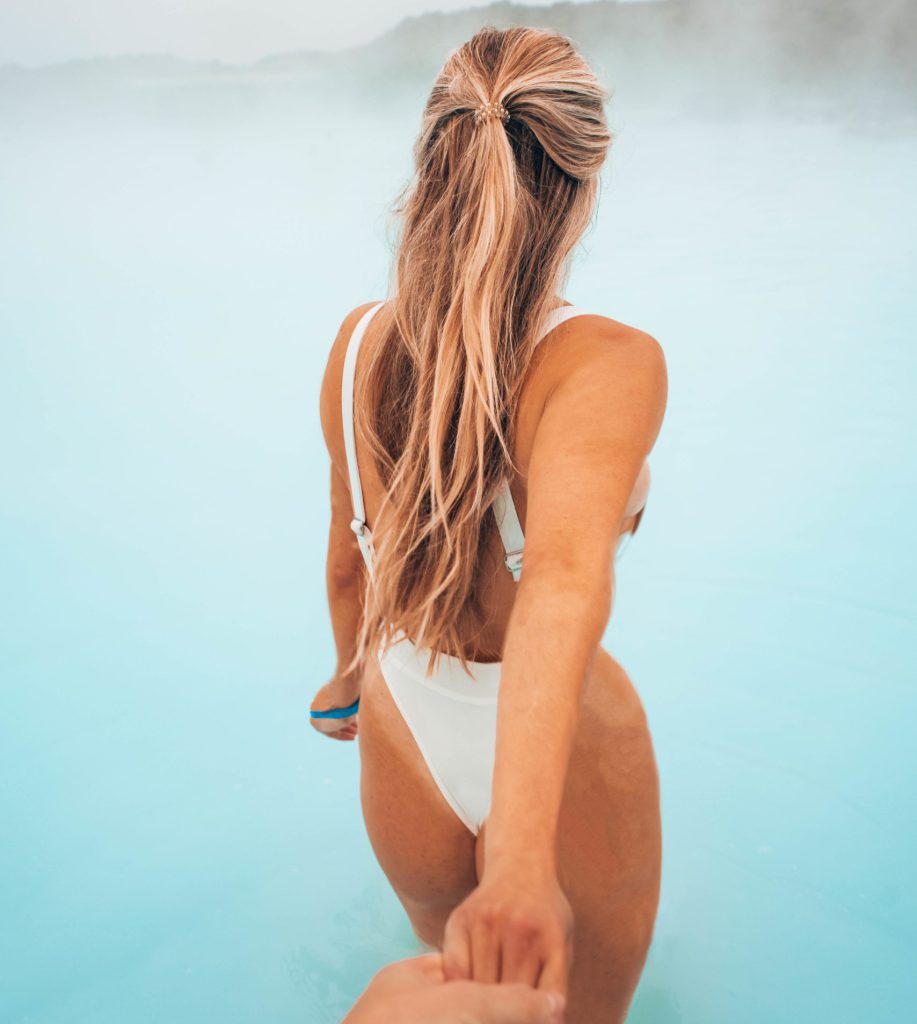Let me introduce you to the hidden gem of the Grand Canyon - Havasu Falls! Nestled within the Havasupai Indian Reservation, this breathtaking natural wonder is renowned for its turquoise waters and awe-inspiring beauty. However, reaching Havasu Falls is no easy feat, as it requires careful planning and preparation. In this blog post, I'll share my firsthand experience and provide you with all the essential information you need to make the most of your trip to this extraordinary destination.
COVID-19 Update: All Havasupai tourism updates are available at the Havasupai Reservations site
Preparations for Havasu Falls & Havasupai
Havasu Falls isn't easily accessible, but trust me, it's worth every effort. Whether you choose to take a helicopter, hike, or ride a mule, getting to the falls is an adventure in itself. The 13 km (8 mile) hike takes about 4 hours each way, plus an additional 3 km (2 miles) to reach the actual falls. If you prefer a shorter hike, consider the helicopter option. Alternatively, the Havasupai Lodge at Supai Village offers a comfortable stay with showers, toilets, and cozy beds.
Havasu Creek, world-famous for its turquoise color, starts out as a trickle of snow run-off and rainwater before it travels about 80 km (50 miles) entering Havasu Canyon. The water stays at about 21 °C (70 °F) all year round. The creek runs through the village of Supai, and it ultimately flows into the Colorado River at the bottom of the Grand Canyon.
Havasu Falls by Helicopter
There is a fancy helicopter transportation option during certain times of the year that will fly you in and out of the canyon and from The Hilltop to a landing area at Supai Village if that is more your style. This will knock out 32 km of the overall hiking required to see the falls. You will still have to hike a bit to get to the falls, but it definitely cuts down on the distance for $85 each way. We originally planned to hike both ways but got so delayed in traffic it wasn't possible for us to get to the falls another way than in a helicopter due to the extreme heat, i'm so glad we did though because the views were absolutely stunning and the total air time was only 2 minutes or so. For more information on the helicopter rides into the canyon, you can read here.
Havasupai Lodge at Supai Village
If camping isn’t your style, there is a lodge at Supai Village that you can stay at. The lodge isn’t necessarily 5-star quality, but it does have showers and toilets and comfy beds to sleep on. You can find more information on the lodge here.
Havasupai Pack Mules
(Fees are per Pack Mule)
Between Hilltop Trailhead and Campground Entrance and Back: $400 round-trip.
One Pack Mule can carry up to 4 bags. Maximum weight: 14 kg (32 pounds) per bag.
ALL Pack Mules must be reserved in advance of your visit at HavasupaiReservations.com
Hiking in the Grand Canyon during the summer can be scorching hot, with temperatures reaching up to 46°C (115°F). To combat the heat, start your hike early in the morning and take frequent breaks to swim in the refreshing Havasu Creek. Keep in mind that if the temperatures exceed 46°C (115°F), the trails into Supai may be closed for safety reasons. Stay hydrated, wear appropriate clothing, and protect yourself from the sun with sunscreen and a hat.
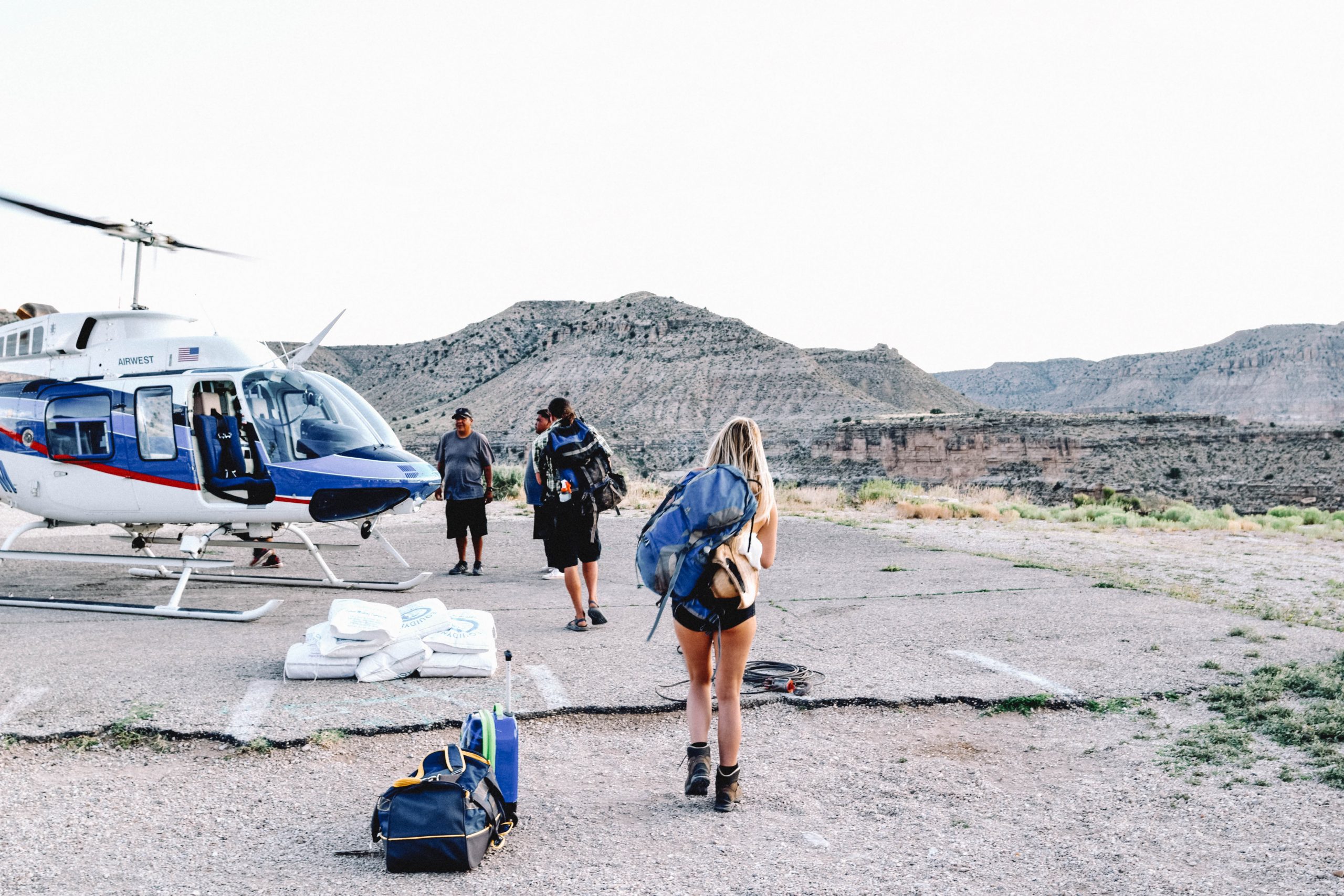 Getting a Permit to Havasu Falls
Getting a Permit to Havasu Falls
Securing a permit for Havasu Falls is the most challenging part of the journey. The demand for permits is high, and they sell out quickly. To obtain a camping permit, you must purchase it through the Havasupai tribe’s reservation website. You MUST make an account on the Havasupai website in order to get a campsite reservation, and it’s best to do this in advance as permits are limited to 300 per day. The cost ranges from $300-$375 USD, depending on the dates, with weekends being slightly more expensive. Remember, walk-ins are not allowed, and day-through hiking is prohibited. When I went hiking into Havasu Falls, we did the trip in 3 days and 2 nights (but since 2019 they do not let you only book 2 nights anymore; you must buy a 3 night/4 day camping permit to hike to Havasu Falls).
Havasu Falls Tours & Guided Trips
There are also some guided trips to Havasu Falls. If you were unable to get a permit yourself like us but really want to go on this hike, this could be an option for you. Companies like Pygmyguides provide some 3 day and 4 day trip options to visit the falls. Price for 4 days: Approx $1555 per person.
Gratuity (8-15% suggested) and 7% AZ sales tax not included.
Trip fees include: transportation from Flagstaff to the trailhead and back; Havasupai entrance, camping and reservation fees; group gear; food; professional guide; and transport of supplies in and out of the Canyon.
Trip fees exclude: airfare, trip insurance, hotels, alcohol (alcohol is prohibited and banned by the tribe), guide gratuity, and services not specified.
IMPORTANT! BE SURE TO BRING: Your photo ID (especially if your name is the one holding the reservation), a printed copy of the email confirmation of your campground reservation or at least a screenshot of your reservation on your phone. Also make sure that you know your license plate number (or have a photo of it) of your vehicle that is parked at the trailhead. These things are all required at check in!
Be prepared to throw down some cash for this hike, but trust me, it is totally worth the cost! If there is ever a hike that you spend a bit of money to experience, this is definitely one of them!
When All Permits to Havasu Are Sold Out
Don't lose hope if permits are sold out when you try to book. The Havasupai tribe's website has a cancellation/transfer list list where permits become available. It’s price-controlled so people cannot elevate the price for profit. Additionally, check the reservation Facebook group and relevant online forums for people selling their permits at fair prices. Regularly monitoring these platforms can increase your chances of finding an available permit.
Havasu Falls Hike Map & Route
Hiking the Havasu Falls Trail is a straightforward experience thanks to well-defined and well-signed trails. Refer to the provided trail map to familiarize yourself with the key milestones of the hike and the location of the five major waterfalls. Click here to access an interactive map for a more detailed exploration.
[row cols_nr="2"][col size="6"] [/col][col size="6"]
[/col][col size="6"]
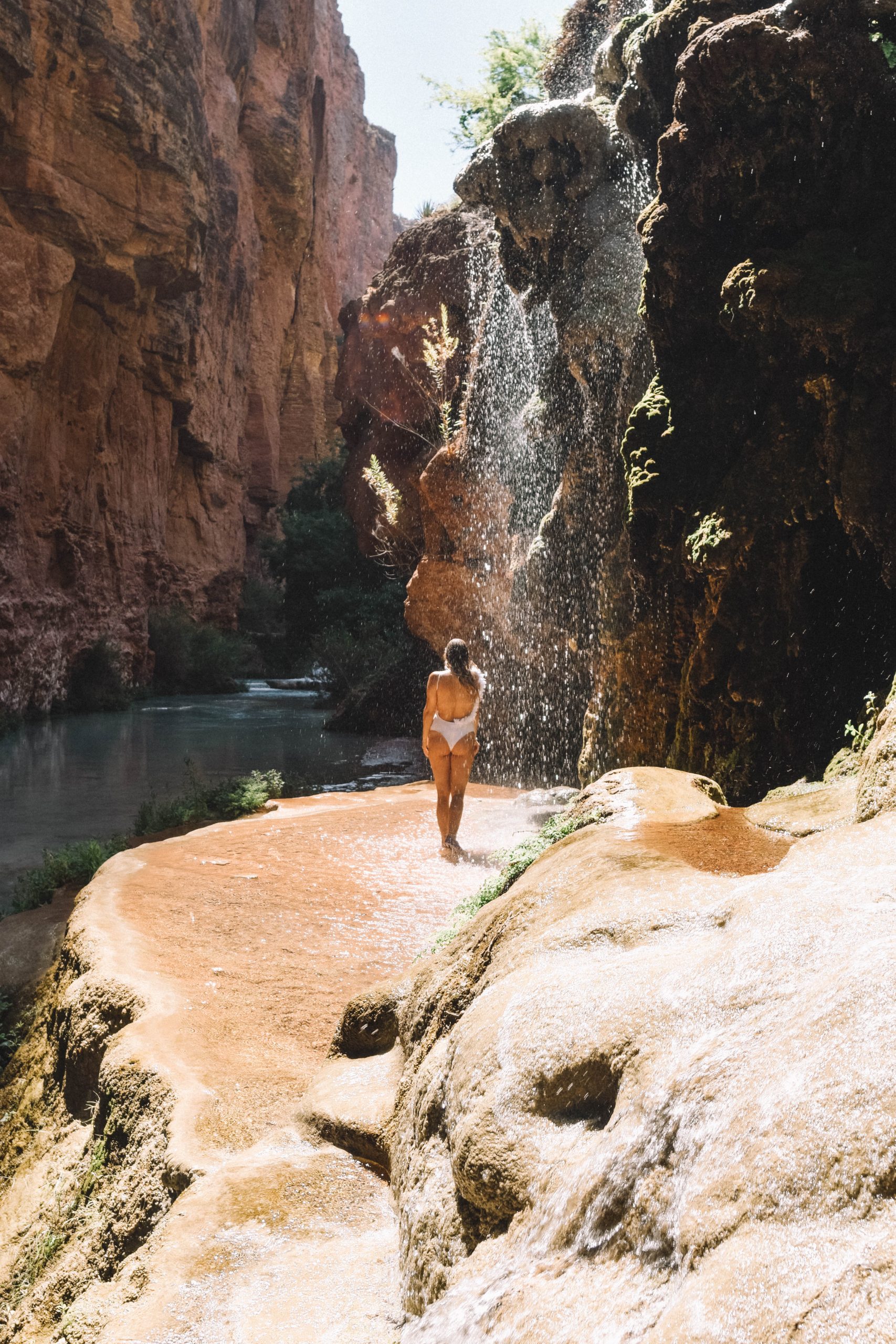 [spacer][/col][/row]
[spacer][/col][/row]
Havasu Falls History
Havasu Falls derives its name from one of the five main waterfalls in the area. The region is home to the Havasupai Tribe, historically known as the Havasu Baaja, meaning "people of the blue-green waters." The Supai Village, situated within the Havasupai Indian Reservation, is recognized as the most remote village in the United States. The tribe's supplies and mail are transported by pack animals and helicopters.
A brief (very high level) history:
- The Havasu Baaja people thrived for centuries in this area thanks too the aquifer that suppplies water to this area we now know has Havasu Falls.
- 1776: The first white man, Padre Garces, discovered the Havasupai area and tribe
- 1882: The Havasupai tribal lands were reduced to 518 acres by the federal government, which forced hard times on the tribe
- 1919: The creation of Grand Canyon National Park - Havasupai is now surrounded by National Park land
- 1975: 185,000 acres were re-distributed back to the tribe and this region is now very prosperous again due to tourism.
- The Grand Canyon was established as a national monument by Teddy Roosevelt in 1908 - Congress upgraded the monument to a national park in 1919.
- It’s famous - it’s a World Heritage Site and one of the 7 natural Wonders of the World.
- It’s big - approximately 1.2 million acres, 277 miles long, 10 miles across and 1 mile deep.
- It’s old - at least according to the geologists. The Vishnu Schist rock type at the bottom is 1.4 - 1.7 billion years old.
- With each step below the rim, you travel back approximately 60,000 years in the earth’s history.
- 5 of the 7 life zones and 3 of the 4 desert types in North America are present.
- Over 1,500 plant, 355 bird, 89 mammal, 47 reptile, 9 amphibian, and 17 fish species make the park their home.
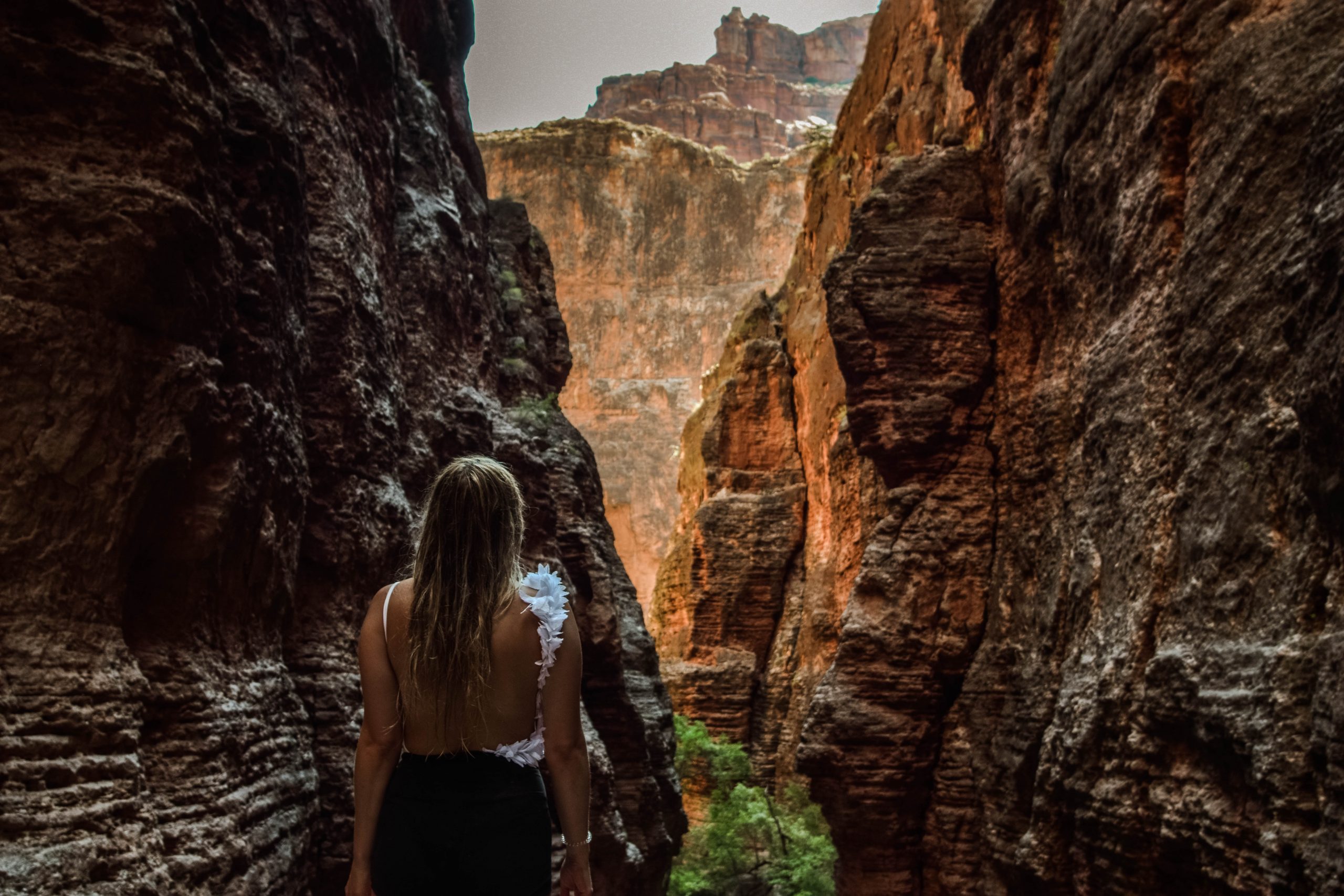 Getting to the Havasu Falls Trailhead
Getting to the Havasu Falls Trailhead
The Havasu hike is located just outside the boundaries of Grand Canyon National Park in Arizona. It can really vary on how long it takes you to drive there, but I've listed some estimates below.
The two closest airports to Havasu Falls are Las Vegas (4 hours) or Phoenix (5 hours).
For guided tours Havasu trips originate in Flagstaff, Arizona. Flagstaff has a small airport served by Horizon and US Airways. From the Flagstaff Airport one can take a taxi into town. One can also fly into Phoenix and rent a car or take a shuttle to Flagstaff. This is often your cheapest option. It is a 2.5-hour drive from Phoenix to Flagstaff.
Shuttle From Phoenix Airport to Flagstaff:
Arizona Shuttle and Arizona Executive Transport run daily vans to Flagstaff:
Arizona Shuttle 1-877-226-8060
Arizona Executive Transport 1-602-475-1125
Car Rentals:
Avis: 800-331-1212; Hertz 800-654- 3131; National: 800-227-7368; Thrifty: 800-367-2277; Alamo: 800-327-9633
To get to the trailhead you will be traveling to Hualapai Hilltop Parking Lot which is located at the end of Indian Road 18. Whether you are coming from the east or the west, you will turn onto U.S. 66 highway in Arizona. Keep an eye out for for Indian Highway 18, and turn onto this road. You will then travel 100 km (63 miles) about 1.5 to 2 hours north to Hualapai Hilltop Parking Lot.
Make sure you have enough fuel in your car to cover about 320 km (200 miles) of driving before you get onto the Indian Road 18. The closest stations around about 110 km (70 miles) away from the trailhead at Peach Springs and the Grand Canyon Caverns area. The next closest gas stations are in Kingman and Seligman and Ash Fork.
Parking at Hualapai Hilltop:
There is plenty of parking space for all visitors and there are currently no fees to park here. Keep attention to the parking signs in the area though, because violating the parking regulations could result in your car getting towed. RV parking is very tight.
Havasu Falls Camping
Looking for the perfect camping spot in Havasu Falls? Well, you're in luck! The Havasupai Falls campgrounds offer a "first-come-first-serve" policy when it comes to picking your tent location. Picture this: a mile-long campground area nestled between Havasu Falls and Mooney Falls in the Grand Canyon. Most campsites are along Havasu Creek, so keep an eye out for clearings and benches to claim your slice of paradise. The campground offers flat areas, making it a breeze to set up camp. And if you're a fan of hammock camping, the abundance of trees will give you plenty of options to hang your cozy nest. Remember, you must camp exclusively at the Havasupai Campground during your hike.
Where to Get Water in Havasu Falls:
When it's time to quench your thirst, head to the water spigot conveniently located at the campground entrance. Camping near the entrance might just be the smartest move you'll make.
Bathrooms in Havasu Falls:
We all know nature calls at the most inconvenient times. Luckily, there are four well-maintained bathrooms scattered throughout the campground area. So, you can take care of business without having to sacrifice your comfort.
Cooking and Campfires in Havasu Falls:
Campfires are a no-go at Havasu Falls. But fear not, backpacking stoves are allowed. So, pack your favorite camping meals and get ready to whip up some delicious dishes under the stars.
Havasu Falls Camp Rules:
Let's keep the good vibes flowing by following a few camp rules. No blaring music, folks! We want to preserve the tranquility of this magical place. Quiet hours are from 8 pm to 5 am, so keep it down and let everyone enjoy a peaceful slumber. Oh, and remember, no alcohol or drugs allowed. But the most important rule of all—no littering! Seriously, folks, let's leave no trace. Be respectful of this sacred tribal land and pick up after yourself. Let's ensure that future generations can experience the wonders of Havasu Falls too. This isn't an all-inclusive resort—it's a cherished natural gem that we must protect.
Animals at the Campground:
While you're enjoying the great outdoors, keep in mind that small critters like mice and squirrels call this place home too. So, zip up those food bags and keep your treats locked away to avoid any unwelcome visitors.
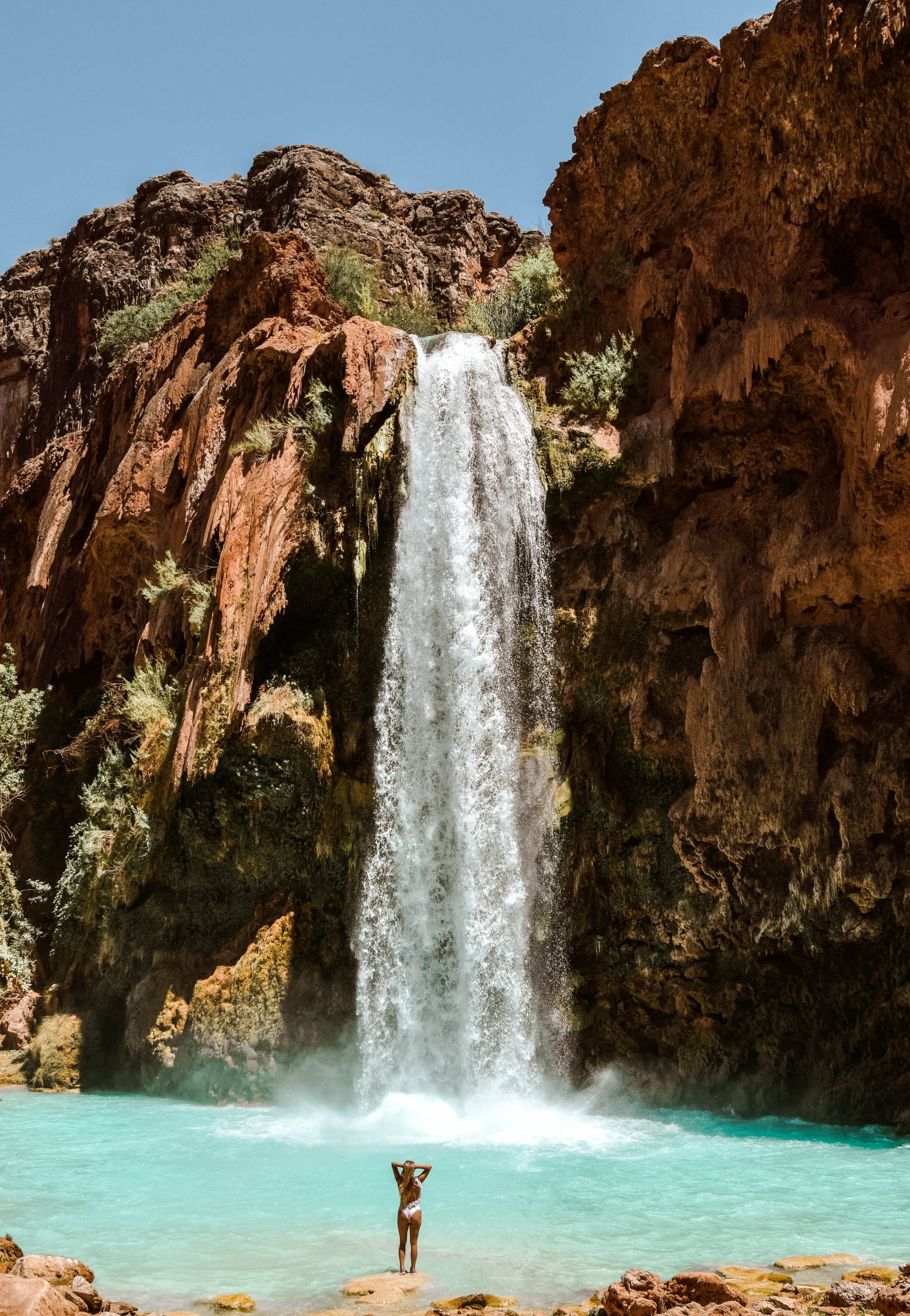
Havasu Falls Itinerary & Trip Details
Note: The itinerary below is just an example based on my previous hike before the new rule of a minimum 3-night, 4-day booking. Adjustments may be required based on the latest guidelines.
Day 1: Hualai Hilltop to Fifty Foot Falls and Navajo Falls
Rise and shine, early birds! Start your day bright and early to beat the scorching summer sun.
If you're on a guided tour, hop on the shuttle to Hualapai Hilltop. It's about a 3.5-hour drive from Flagstaff, so buckle up and enjoy the ride. Departure from Flagstaff is at 2 or 3 a.m., ensuring you beat the heat and make the most of your adventure.
Mileage: 16 km (10 miles)
Elevation Loss: 730 m (2,400 feet)
Once you reach Hualapai Hilltop, the real hiking fun begins. Prepare yourself for a downhill journey through a series of switchbacks. The trail will then lead you into a breathtaking red sandstone canyon. After hiking for about 7 km (4 miles), you'll reach the intersection of Cataract Canyon and Havasu Creek. Brace yourself for a sight that will leave you speechless—the enchanting turquoise waters of Havasu Creek. Follow this picturesque creek for another 3 km (2 miles) until you reach the village of Supai. Here, you'll need to check in and have your reservations confirmed. They'll even give you snazzy orange wristbands to wear throughout your adventure. With wristbands secured, it's time to continue your hike to the first two waterfalls: Fifty Foot Falls and Navajo Falls.
Take your time to explore these magnificent falls, capturing Instagram-worthy photos, frolicking in the refreshing waters, and fully immersing yourself in the beauty of nature. Afterward, continue your hike for another 3 km until you reach the campground. Settle in and let the rest of the day be dedicated to capturing the beauty of Havasu Falls. With numerous camping sites nestled beside the water under the protective branches of cottonwood trees, you'll have the perfect spot to pitch your tent or simply snooze under the starry night sky.
Highlights of Day 1: Explore 3 waterfalls Fifty Foot Falls, Navajo Falls, and Havasu Falls.
Day 2: Havasupai Falls Campground to Mooney and Beaver Falls (and back)
Mileage: 11 km (7 miles) (optional day hiking)
Elevation Change: 150 m (500 feet)
On your second day, get ready for some more adventure as you explore Mooney Falls and Beaver Falls. Mooney Falls is about 1.6 km (1 mile) from the campground and requires a bit of a descent down a series of ladders and chains. It can be a thrilling experience, but take it slow and be cautious. Once you reach the base of Mooney Falls, you'll be rewarded with a spectacular view of the 60-meter (200-foot) waterfall cascading into a beautiful pool below. Feel free to take a refreshing dip or simply admire the awe-inspiring sight.
After enjoying Mooney Falls, continue your journey to Beaver Falls, which is another 4.8 km (3 miles) downstream. The trail will take you through stunning landscapes, including lush greenery, turquoise pools, and natural rock formations. Be prepared to cross the creek multiple times, so wearing appropriate footwear is essential. When you finally arrive at Beaver Falls, you'll be greeted by a series of cascades and pools, perfect for swimming, cliff jumping, and just immersing yourself in nature's beauty.
Highlights of Day 2 & 3: Explore 2 waterfalls Mooney Falls and Beaver Falls. Depending on how tired you feel, you can take it easy on day 2 and do more hiking on Day 3, or vice versa. Go at your own pace, there is plenty to do and see on the trail!
Day 3: Havasupai Falls Campground back to the parking lot
Mileage: 16 km (10 miles)
Elevation Change: 730 m (2,400 feet)
On our third day, the sun had barely risen when we woke up at 3 am, fueled by excitement and the determination to make the most of our remaining time in this enchanting oasis. The hike from the campground back to the trailhead awaited us, a journey that would take around 4 hours. We knew we had to hustle, as the scorching sun would soon make its presence known.
The heat is on! Brace Yourself for the Hike Out As we embarked on our journey out of the canyon, we quickly realized that the heat could be relentless. The trail offered little shade, and depending on the time of year, it could feel like walking through an inferno. Even in the pleasant mid-80s of March, the heat was quite intense. So, if you're planning to tackle this adventure during the summer, consider starting your hike in the early hours of the morning, around 4 am or earlier. Alternatively, you can extend your stay, taking advantage of the cooler temperatures in the early evening to make your way back. Remember, staying safe and hydrated is key!
Flash Flood Warning... Embrace Nature, Respect its Power Late July and August bring the monsoon season to the Southwest, including Havasu Canyon. While this period adds a touch of magic to the landscape, it also comes with a risk of flash floods. Although these events usually do not pose a direct safety risk, it's essential to stay informed and check the weather forecast closer to your hiking day. Flash floods have reshaped the landscape of Havasu Falls, even washing away the original Navajo Falls in 2008. Nature's power is awe-inspiring, and respecting it might is crucial.
Navajo Falls Guide:
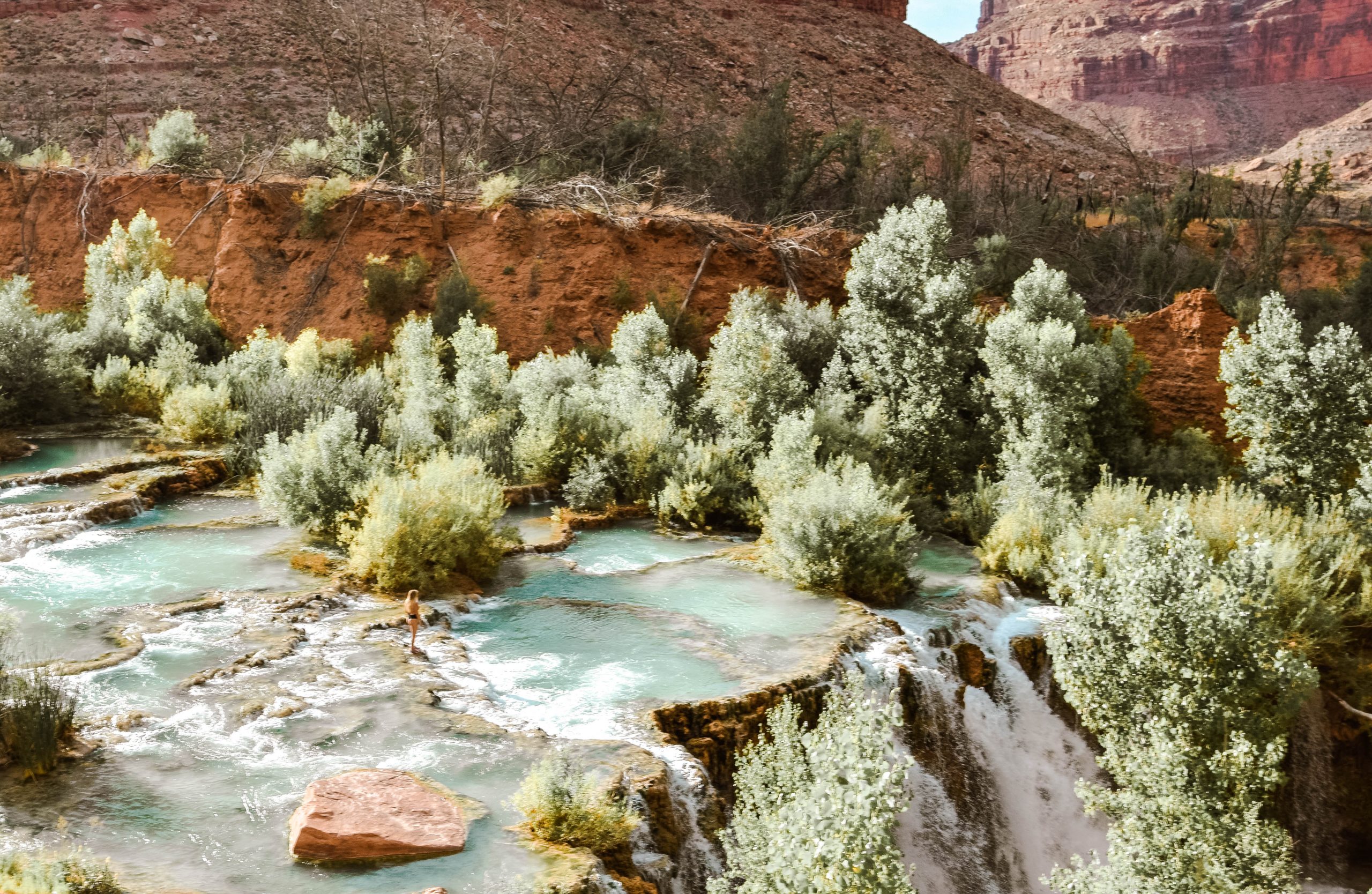
Navajo Falls emerged as a hidden gem following a powerful flash flood that reshaped Havasu Canyon in 2008. This incredible spot, located just over 0.5 miles from the Havasupai Campground, offers a refreshing escape from the crowds. To witness its beauty, embark on a short hike from the campsite. Explore Upper Navajo Falls and Lower Navajo Falls, connected by a captivating series of cascades. Many hikers miss Upper Navajo Falls, as it is partially concealed from the main trail. So, be sure to channel your inner explorer and discover this often-overlooked fifth waterfall of Havasu Canyon. It's a sight to behold!
Havasu Falls Guide:
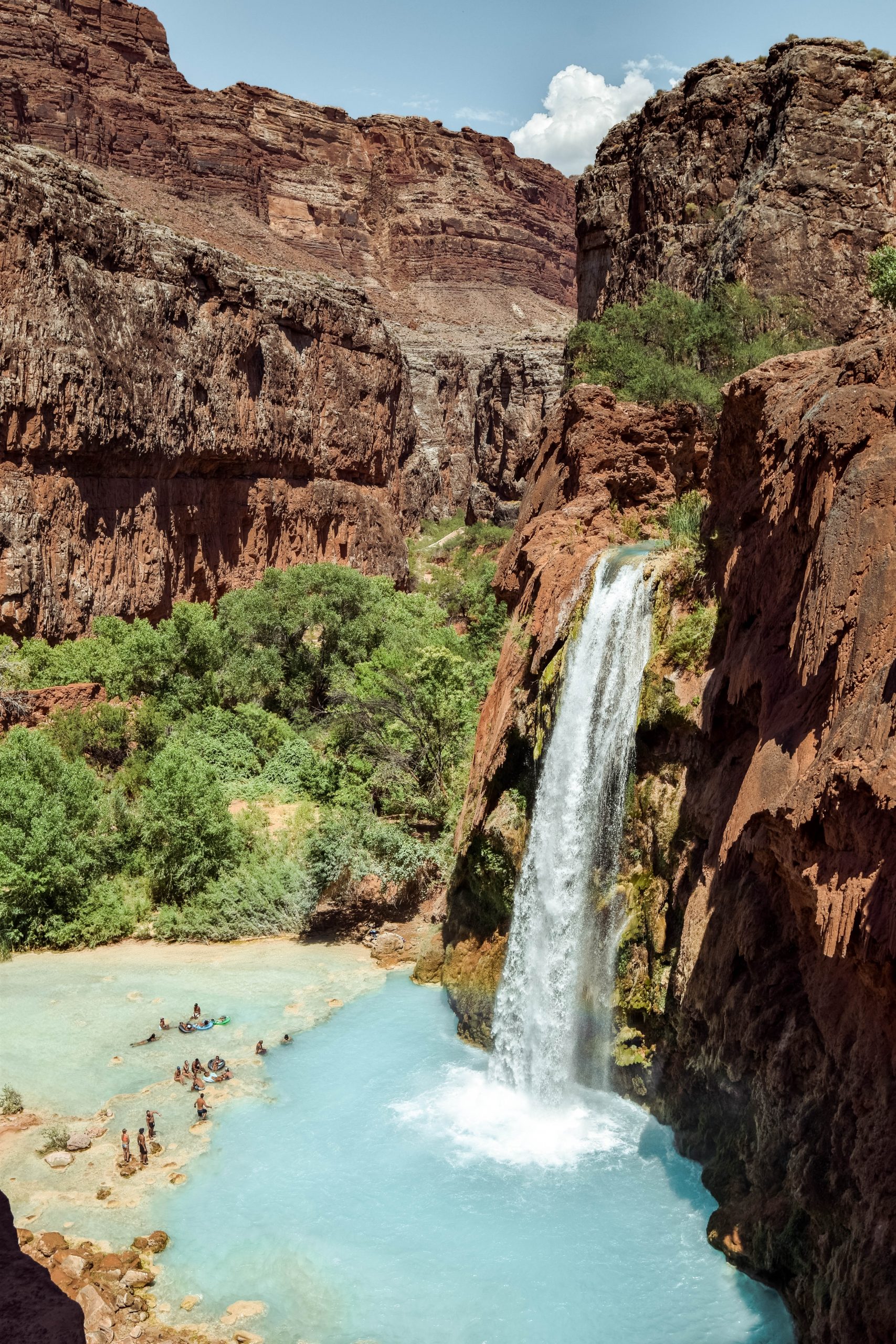
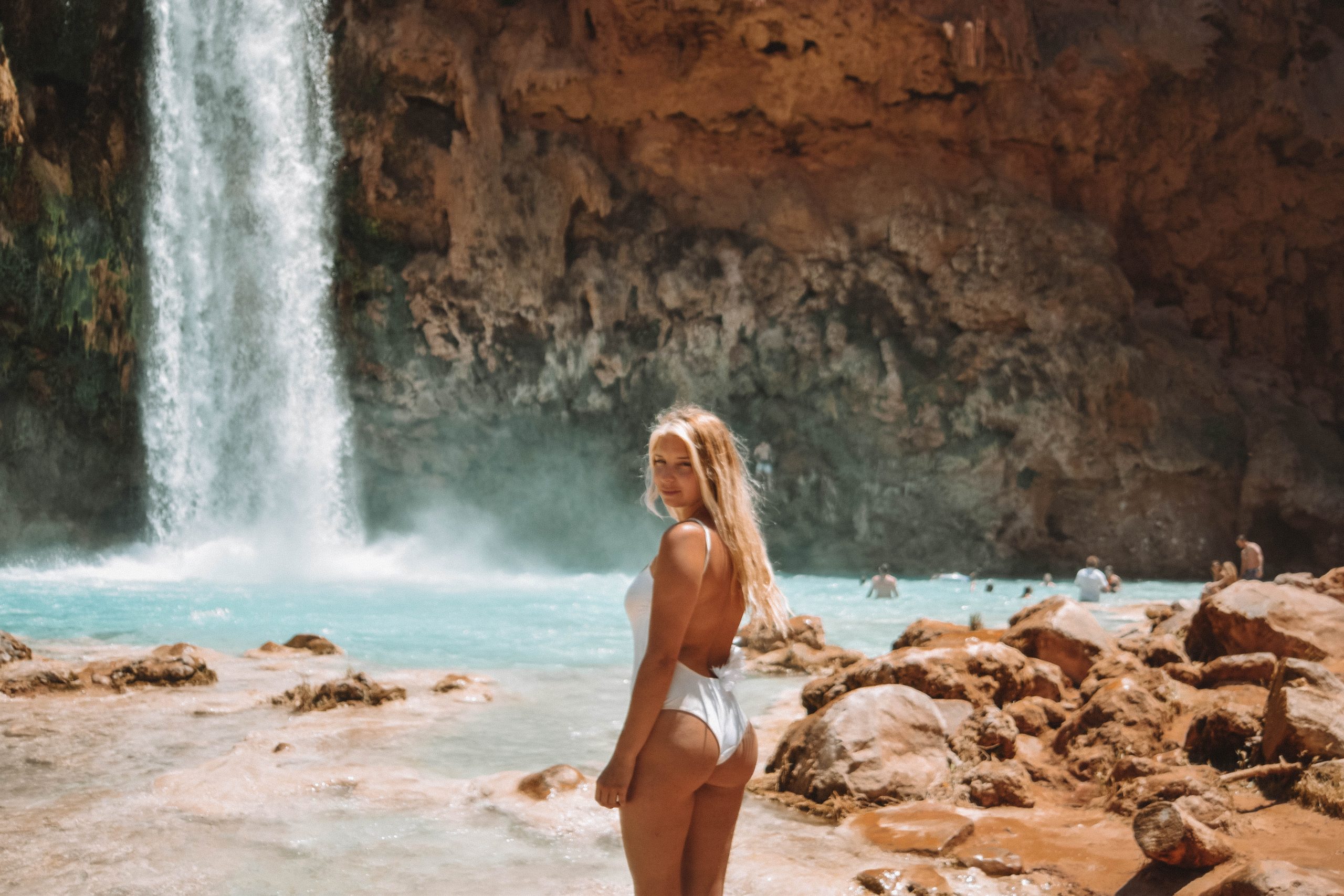 Prepare to be awe-struck by the most famous of all the falls in Havasu Canyon—Havasu Falls. Just 1.5 miles from the village of Supai, these falls are an absolute must-see. As you approach the campground, you'll hear the thunderous roar of water, signaling the magnificence that lies ahead. Witness the grandeur of a 90-foot vertical drop, forming a series of enchanting plunge pools. Throughout history, the appearance of Havasu Falls and its plunge pools has transformed due to the effects of flash floods. Once known as Bridal Veil Falls, the current configuration emerged in 1910 and continues to mesmerize visitors with its beauty. Get ready for a truly mesmerizing experience!
Prepare to be awe-struck by the most famous of all the falls in Havasu Canyon—Havasu Falls. Just 1.5 miles from the village of Supai, these falls are an absolute must-see. As you approach the campground, you'll hear the thunderous roar of water, signaling the magnificence that lies ahead. Witness the grandeur of a 90-foot vertical drop, forming a series of enchanting plunge pools. Throughout history, the appearance of Havasu Falls and its plunge pools has transformed due to the effects of flash floods. Once known as Bridal Veil Falls, the current configuration emerged in 1910 and continues to mesmerize visitors with its beauty. Get ready for a truly mesmerizing experience!
Mooney Falls Guide:
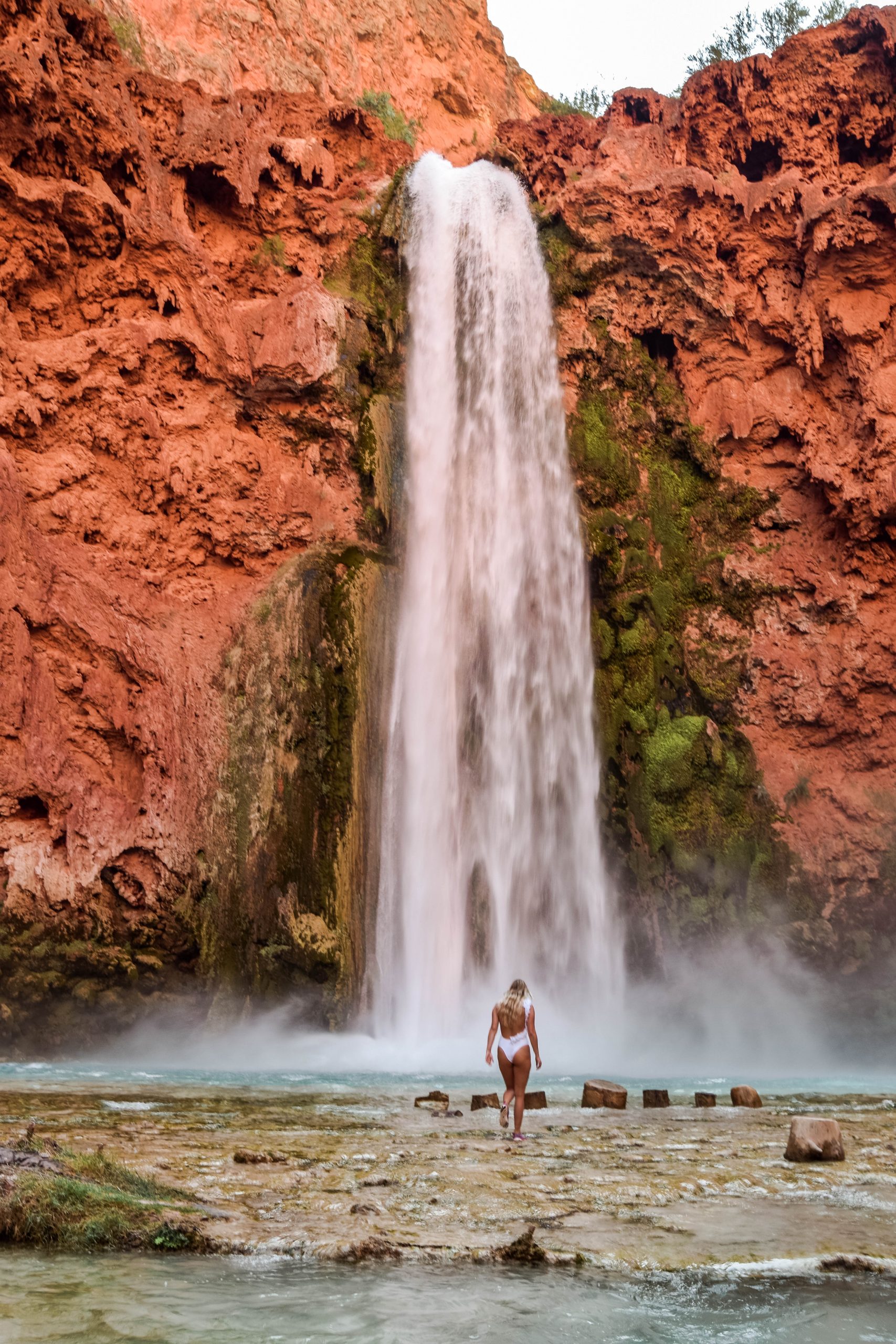
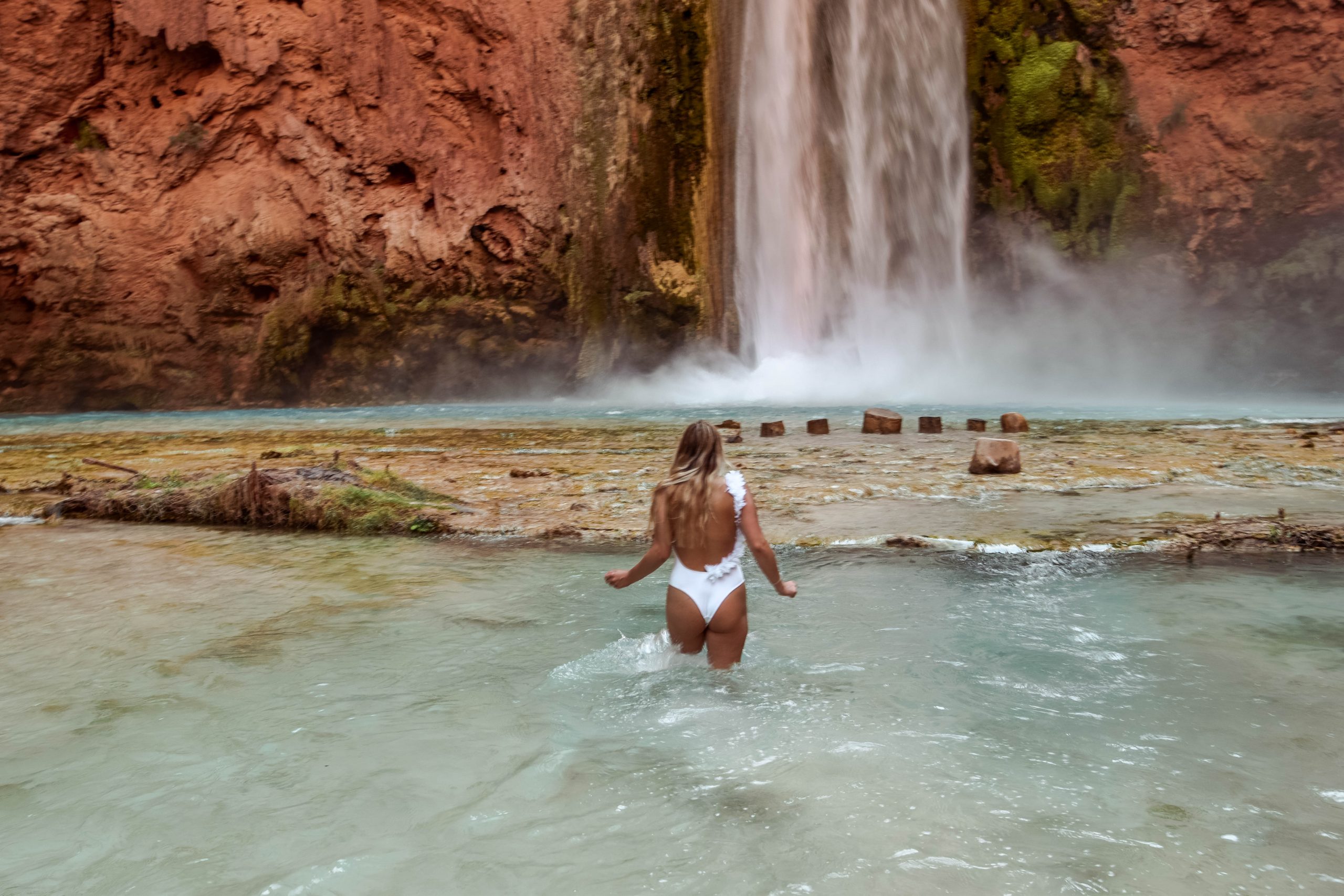
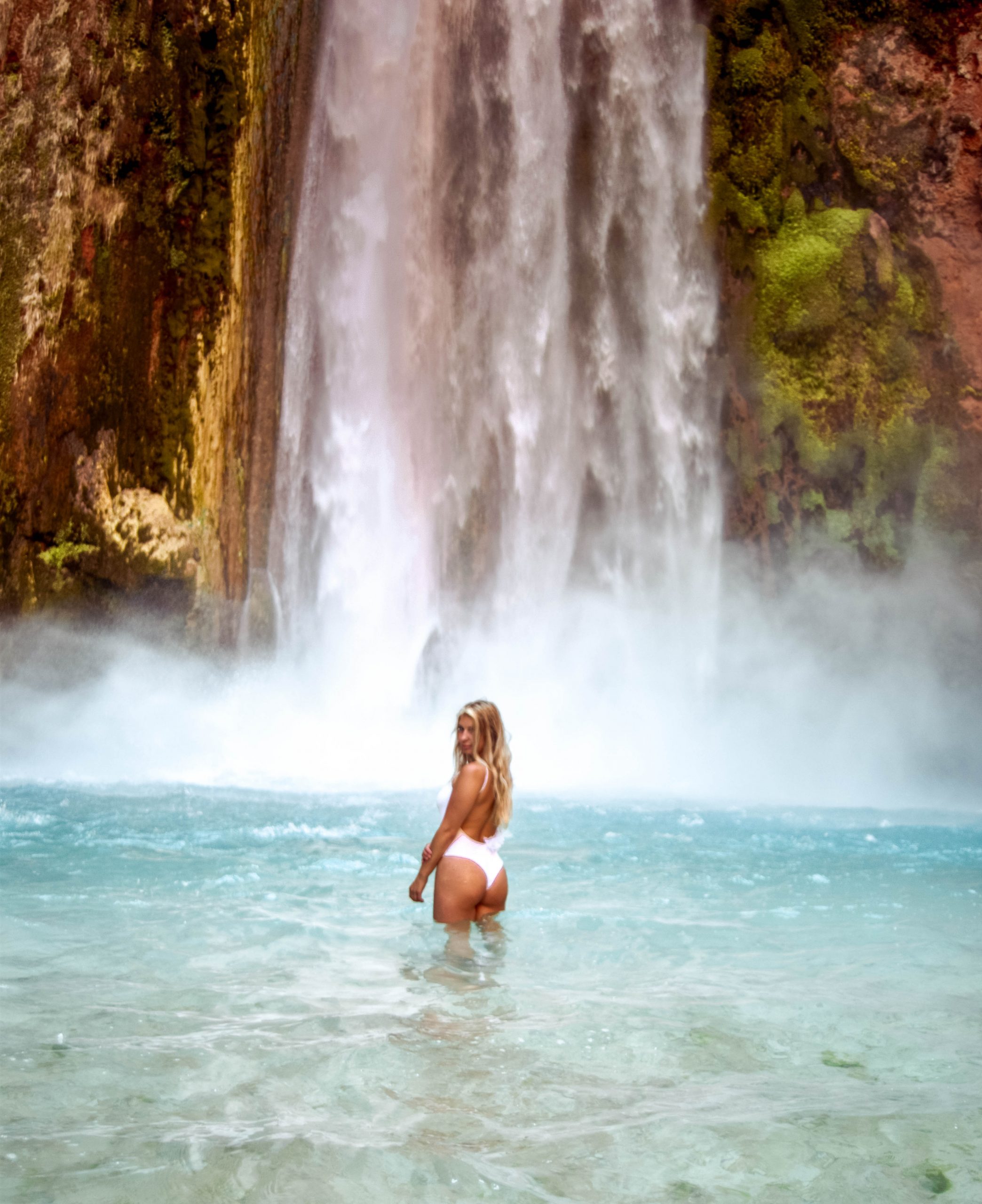
Brace yourself for an exhilarating adventure as we journey to Mooney Falls. To reach the bottom and immerse yourself in its refreshing pool, you'll need to conquer a rugged and daring descent. Wooden ladders, chains, and caves will guide your way, adding an extra element of thrill. The trail starts against the left side of the canyon wall and gradually becomes more challenging as you navigate through small caves. At the end of the second cave, prepare for a vertical rock climb akin to descending a ladder. Fear not, for strategically placed chains, handholds, and ladders assist you along the way. Mist from the falls adds an extra touch of excitement, making the rocks slippery. Remember to descend backward, like you would on a ladder, to make the journey easier.
The risk is worth the reward, and I assure you, you've got this!
TIP: If you want to have the place to yourself and take the best photos, make sure to do Mooney Falls in the early morning.
[row cols_nr="2"][col size="6"]
[/col][col size="6"]
[spacer][/col][/row]
Havasu Falls Packing Checklist
When it comes to clothing, it's all about being prepared for changing seasons and weather conditions. Here's a checklist of must-have items:
Sturdy hiking boots, Opt for mid-weight, above-the-ankle boots with lug soles. Remember to buy them ½ - 1 size larger than your street shoes to accommodate swelling and thicker socks.
Brimmed sunhat, cap or bandana, Shield yourself from the sun's rays and stay cool.
Rain shell, A waterproof and breathable jacket will keep you dry during unexpected showers.
Warm top, Pack a long-sleeved sweater or fleece jacket for cooler evenings.
One or two hiking t-shirts, Choose one or two long-sleeved shirts for sun protection. Light colors are cooler than dark ones.
Long pants, Pack a pair of leggings or lightweight trousers to block the sun and provide warmth at night.
Shorts, Opt for nylon shorts, which are lightweight and can double as swimwear.
Bathing Suit, Don't forget to bring your swimsuit for refreshing dips in the falls.
Underwear, Pack enough for your trip duration.
Supportive water footwear Invest in water shoes like 5Finger® or Tevas® for comfortable walking in and out of the creek. No flip-flops, please!
Hiking socks, Bring one pair for every two days of your trip. Look for recommended brands like Bridgedale®, Smartwool®, or similar padded socks. Wearing a thin liner sock underneath is highly recommended. Remember, no cotton socks!
Additional clothing October - April
Warm hat and gloves, Stay cozy during cooler months.
Long underwear, Pack lightweight to midweight wicking tops and bottoms made of materials like capilene or polypropylene.
Fleece jacket or insulated coat, Choose a warm, lightweight, and packable option insulated with synthetic material.
Rain pant, Don't forget waterproof/breathable pants for added protection during rainy days.
Important note: With the exception of a cotton t-shirt, cotton ball cap, and bandana, avoid wearing cotton as it doesn't dry quickly. These three cotton items can help keep you cool when wet during the hot summer months.
Havasu Falls Gear Checklist
Water bottles or bladder, Stay hydrated with a total capacity of 3 liters.
Camp Towel, Pack a lightweight and quick-drying towel for convenience.
Contact lenses and glasses, If you wear contact lenses, bring a pair of glasses as well, as contacts may become dirty and challenging to clean.
Sunglasses, sunscreen (30+ SPF), lip balm, Protect yourself from the sun's harsh rays.
Headlamp, spare batteries, Opt for an LED headlamp that works with AA or AAA batteries. Don't forget spare bulbs too!
Toiletries, Include a toothbrush, toothpaste, deodorant, and a small washcloth or bandana.
Prescription medicine, Inform your trip leader about any medications you're taking.
Knee braces, if needed
Money, for tipping your guide if on a tour(generally 10-20% of trip cost based on your experience) and for refreshments in Supai.
Additional gear - If not on a guided tour
Backpacks, tents, sleeping bags, camp pillows, sleeping pads, trekking poles, stoves, cookware, and personal bowls, cups, and utensils.
How to Pack for a Havasu Falls trip
Important note: Please pack the above items into a single duffel, 35-50L backpack or soft sack depending on your choice of travel to the campsite. When on the trail - Carry your rain jacket, an extra layer, water bottle/bladder, snacks, sunscreen, camera and anything else you need in your backpack.
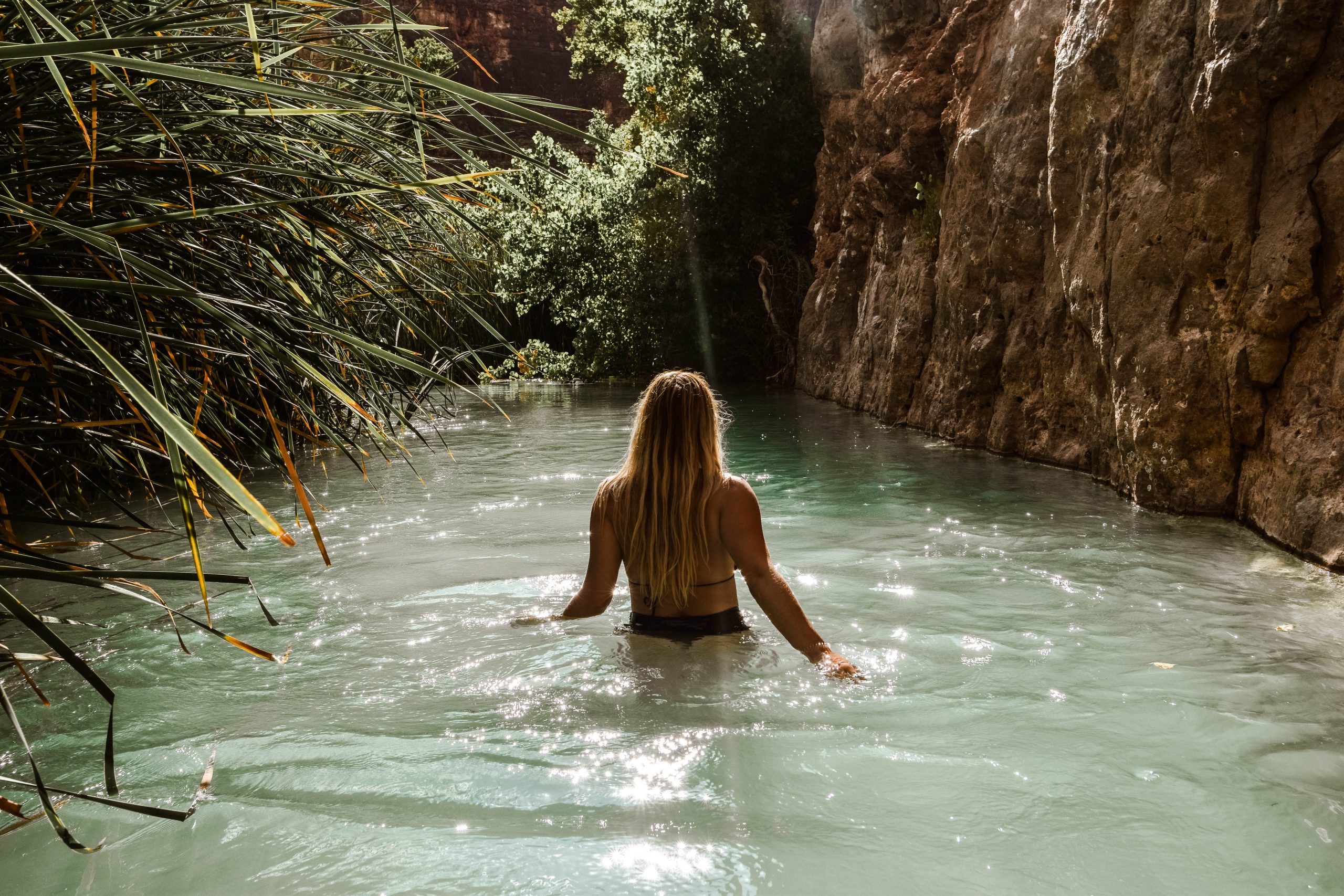
Havasu Falls Food Guide
A guided tour will provide food for you but if you plan to hike by yourself its good to prepare a diversity of foods containing the necessary nutrition for sustained energy output. Meals made from staples that travel well in the backcountry - rice, pastas, lentils, beans, couscous, oatmeal, granola, etc. Meals can also be supplemented with trail foods such as crackers, cheese, granola, energy bars, fresh and/or dried fruit, and energy drink mixes. Remember that every gram counts when you're on the trail. Choose lightweight options to ease your load.
Q&A - Common Havasu Falls Hike Questions & Answers
1) What is the correct name for this hike? Havasu Falls Hike or Havasupai Falls Hike? The trail is commonly known as the Havasu Falls Trail, as Havasu Falls is one of the five waterfalls along the route. Havasupai is the Indian Reservation and translates to "people of the blue-green waters." While some use both names interchangeably, technically, there is no waterfall called Havasupai Falls on the trail.
2) Why is Havasu Falls blue? The mesmerizing blue color of Havasu Falls is a result of the high concentration of calcium carbonate in the water. The limestone that lines the creek reflects this color, creating a stunning visual. It's a scientific wonder! I recommend reading this excellent description of the waters from the UC Davis Educational website.
3) How cold is the water at Havasu Falls? Expect a refreshing water temperature of around 21°C (70°F) year-round.
4) Can I day hike the Havasu Falls Trail Unfortunately, day hiking is not allowed on this trail. All hikers must obtain a wristband after checking in with the Supai Village to access the Havasu waterfalls. Embrace the adventure and plan for a minimum of 3-4 days to fully appreciate this remarkable trail.
[spacer]
Phew! That was an epic trail guide!
At this point, if I haven't convinced you to get some permits and go backpacking here, then I don't know what I'm doing with my life! The Havasu Falls pictures alone can speak for themselves quite honestly, so make it happen! It's worth the effort, even if it takes a few tries.

